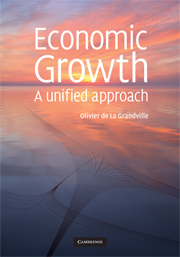Book contents
- Frontmatter
- Contents
- Introduction
- PART I POSITIVE GROWTH THEORY
- PART II OPTIMAL GROWTH THEORY
- PART III A UNIFIED APPROACH
- 11 Preliminaries: interest rates and capital valuation
- 12 From arbitrage to equilibrium
- 13 Optimal savings: a general approach
- 14 Problems in growth: common traits between planned economies and poor countries
- 15 From Ibn Khaldun to Adam Smith, and a proof of Smith's conjecture
- In conclusion: on the convergence of ideas and values through civilizations
- Further reading, data on growth and references
- Index
13 - Optimal savings: a general approach
Published online by Cambridge University Press: 01 February 2010
- Frontmatter
- Contents
- Introduction
- PART I POSITIVE GROWTH THEORY
- PART II OPTIMAL GROWTH THEORY
- PART III A UNIFIED APPROACH
- 11 Preliminaries: interest rates and capital valuation
- 12 From arbitrage to equilibrium
- 13 Optimal savings: a general approach
- 14 Problems in growth: common traits between planned economies and poor countries
- 15 From Ibn Khaldun to Adam Smith, and a proof of Smith's conjecture
- In conclusion: on the convergence of ideas and values through civilizations
- Further reading, data on growth and references
- Index
Summary
Enrich the time to come with smooth-faced peace,
with smiling plenty and fair prosperous days
Richmond (King Richard III)In chapter 10 we described the serious difficulties entailed by the use of utility functions in the definition of optimal savings policies. We then suggested to look for optimal investment paths that would maximize the sum of time-discounted consumption flows. This is what we will now do.
We will be led to show that the theory of economic growth should not be separated into two strands: positive, or descriptive theory on the one hand, and normative theory on the other. Traditionally, the literature has indeed asked two different types of questions: what would be the evolution of the economy if the investment-savings rate were a given, exogenous, rate s? And another question was: what should be the savings rate if some global welfare objective were to be attained? It is essential here to understand that when asking the first question, we assume the economy to be competitive, and in consequence the basic marginal equalities apply: the marginal productivity of labour is equal to the wage rate; the marginal productivity of capital is equal to the real rate of interest. But those very hypotheses are in fact the answer to the apparently unrelated question: how can a society maximize the sum of the discounted consumption flows it can acquire? We will show that the optimal savings rate is endogenous to a competitive economy.
In this chapter, we will deal in detail with this important issue.
- Type
- Chapter
- Information
- Economic GrowthA Unified Approach, pp. 301 - 322Publisher: Cambridge University PressPrint publication year: 2009



